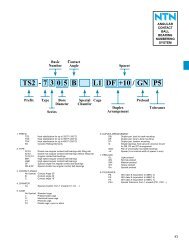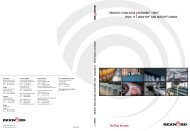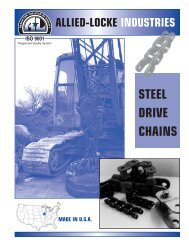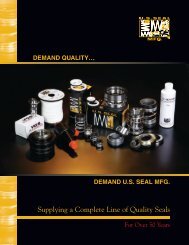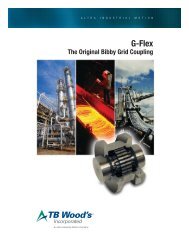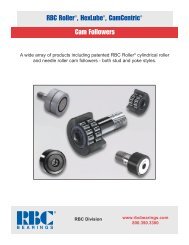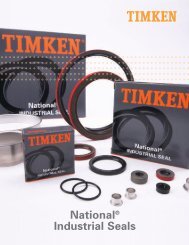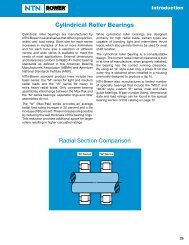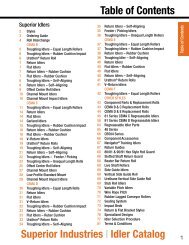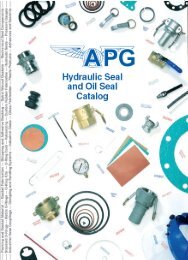Rex Linkbelt Roller Chain Catalog - Norfolkbearings.com
Rex Linkbelt Roller Chain Catalog - Norfolkbearings.com
Rex Linkbelt Roller Chain Catalog - Norfolkbearings.com
- No tags were found...
You also want an ePaper? Increase the reach of your titles
YUMPU automatically turns print PDFs into web optimized ePapers that Google loves.
Takeups • Locate takeups at the foot, or loading, end of theconveyor whenever practical. Screw takeups are ordinarily usedbut where fixed tension is required, such as on long conveyorssubject to wide temperature variations, spring, gravity, orcatenary takeups are re<strong>com</strong>mended.Takeups should have sufficient travel to permit removal of 2pitches of chain.Fig. 7970Fig. 7970Fig. 7970Fig. Fig. 7970 7970 Fig. 7970Fig. 7970Screw takeupUsed where periodic manual adjustments are sufficient.Fig. 7970When operating in a clean atmosphere, lubricate the chain witha neutral grade of straight mineral oil that is fluid enough topenetrate the chain joint.When operating in an abrasive atmosphere lubricate the chainwith a neutral petroleum jelly or a soft grease which, whenheated, be<strong>com</strong>es sufficiently fluid to penetrate into the chainjoint, but at operating temperature is solid enough to hinder theentrance of abrasive materials.When operating at elevated temperatures lubricate the chainwith colloidal graphite dispersed in a suitable carrier.Complete data on lubrication methods and re<strong>com</strong>mendationsare on page E-9.Typical arrangements • The three arrangements illustratedare most <strong>com</strong>monly used to attach slats, pans, crossrods, andsimilar carriers to conveyor chains. Although the illustrationsshow the chains rolling on large diameter rollers, the samearrangements may be used for chains with standard diameterrollers where the chains slide on the edges of the sidebars.Fig. 7971Fig. 7971Fig. 7971Fig. 7971Fig. 7971Fig. Fig. 7971 7971Fig. 7971Gravity takeupUsed where constant adjustment is desirable to <strong>com</strong>pensate forchain wear.Fig. 4706Fig. 4706 Fig.Fig. 47064706Fig. Fig. 4706 4706Fig. 4706Arrangement 1 illustrates the use of A attachments to whichthe carriers are fastened. This arrangement permits rolling onboth the carrying and return runs.EFig. 7972Fig. 7972Fig. 7972Fig. 7972Fig. 7972Fig. Fig. 7972 7972Fig. 7972Spring takeupEspecially useful for shock loading conditions. Due to limitedtravel of the spring, manual adjustments are also necessary.Fig. 7973Fig. 7973Fig. 7973Fig. 7973Fig. 7973Fig. Fig. 7973Fig. 79737973Catenary takeupUseful in long conveyors where the catenary can follow the drivesprocket, thereby relieving chain tension throughout the rest ofthe conveyor. The catenary provides “automatic” tensioning ofthe chain.Lubrication • Conveyor chains must be properly lubricated togive long, trouble-free service.33Fig. 4705Fig. 5075Fig. 4705Fig. 4705Fig. Fig. 4705 4705Fig. Fig. 4705 4705 Fig. 4705Arrangement 2 illustrates a conveyor chain with K attachments.This arrangement gives greater chain stability to wide conveyorsbut permits rolling on only the carrying run. Slide rails supportthe carrier and chain on the return run.Fig. 5075Fig. 5075 Fig. 5075Fig. Fig. 5075 5075Fig. Fig. 5075 5075Arrangement 3 shows the re<strong>com</strong>mended method of attachingcrossrods to a conveyor chain. Tubular crossrods riveted to theextended chain pin, or D attachment, allow some flexibility inchain alignment and may prevent overloading of one strand.E-3




